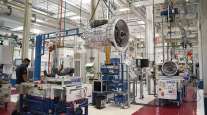Services Industries Grew at a Faster Pace in January

Service industries expanded at a faster pace in January, a sign of progress in the biggest part of the economy that will help the U.S. work through a global slowdown.
The Institute for Supply Management’s non-manufacturing index rose to 56.7 from a six-month low of 56.5 in December, the Tempe, Arizona-based group’s report showed Wednesday. Figures above 50 signal expansion. The median forecast of 73 economists surveyed by Bloomberg called for a January reading of 56.4.
Service providers such as retailers and restaurants are enjoying steady demand as job gains and lower energy prices propel household spending. The industries that make up almost 90% of the economy are a source of strength for the U.S. at a time when the nation’s factories battle the headwinds of slowing overseas markets and a stronger dollar.
The gain “is a little bit of a relief, and a good sign that the economy continues to grow at a decent clip,” said Sarah House, an economist at Wells Fargo Securities LLC in Charlotte, North Carolina, who projected the index would rise to 56.6. “Consumers are still going to be one of the major generators of growth this quarter.”
In contrast, the group’s factory survey released on Feb. 2 was less upbeat. The ISM manufacturing index fell in January to the lowest level in a year as measures of orders, production, exports and employment retreated.
The ISM’s non-manufacturing survey covers an array of industries including utilities, retailing, and health care, along with construction and agriculture. Bloomberg survey estimates for the services gauge ranged from 54.5 to 57.5.
Eight industries reported growth in January, led by food services and finance. Mining, including the oil and gas sector, led the eight industries that contracted.
A gauge of orders climbed to 59.5 in January from 59.2 a month earlier. The business activity index increased to 61.5 from the prior month’s 58.6. The measure parallels the ISM’s factory production gauge.
The group’s employment index decreased to 51.6 last month, the weakest in almost a year, from 55.7 the prior month.
Companies added more than 200,000 workers to payrolls in January for a fifth consecutive month, signaling steady labor-market growth, according to a private payrolls report. The 213,000 increase in employment followed a 253,000 December gain that was larger than initially reported, figures from Roseland, New Jersey-based ADP Research Institute showed Wednesday.
The ISM measure of prices paid fell to 45.5, the lowest since July 2009, from 49.8.
Sustained job creation and lower fuel bills are lifting Americans’ confidence and boosting purchasing power. The addition of almost 3 million jobs and a falling unemployment rate helped make 2014 the best year for the labor market since 1999. A report on Friday may show payrolls rose by 230,000 in January, the 12th consecutive monthly advance exceeding 200,000.
Gasoline is the cheapest since 2009. The price of a gallon of regular gasoline was $2.07 on Feb. 2, according to U.S. auto group AAA. That’s among reasons the University of Michigan consumer sentiment index jumped in January to an 11-year high.
The improvement is filtering through to consumer spending, which grew in the fourth quarter at a 4.3% annualized pace, the most since 2006. The economy advanced at a 2.6% rate, according to Commerce Department data.
Carmakers and auto dealerships are benefiting from strong demand, with readily available credit and an aging vehicle fleet projected to help the industry achieve a record sixth straight year of increases. General Motors Co. and Ford Motor Co. led automakers with the biggest U.S. auto-sales gains in January.
“Leading indicators remain robust with some favorable tailwinds that should support growth” this year, Emily Kolinski Morris, Ford’s chief economist, told analysts and reporters on a conference call on Tuesday. “Low fuel prices provide a significant boost to consumer disposable income and employment conditions remain on a positive track.”
Housing will probably keep improving as well. New residential construction rose in December to cap the best year since 2007, boosted by the improving labor market and mortgage costs close to multiyear lows.


